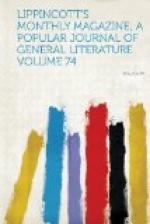Our landlady assures us that let the weather look as
threatening as it would, the sun always contrived to
burst out when in former times the late king rode
into the arena to give the prizes; and she is evidently
by no means certain it will not pour all three days
of the fair this year. However, to judge from
the skies, “this one” is not so bad as
he might be: the sun shines propitious on him
too, and consequently on us as we set forth to see
what we can see. The second is the great day,
as the prizes are then distributed; but already on
Monday the booths and shows were on the field, and
Cannstatt was gay with banners and wreaths and garlands
of green. The carpenters were still hard at work
hammering at seats for us to occupy next day, but
the wonderful triumphal arch stood quite completed
and worthy of sincere admiration. No one knows
who has not seen it worked into an architectural design
how beautiful a string of onions can be, how gorgeous
a row of vegetable-marrows, how delicate a cluster
of turnips. It sounds puerile, but it was lovely
nevertheless. Imagine a temple-like construction
all composed of odorous pine, with an arched portal
on either hand, and then every line and curve, every
niche and pillar and balustrade, defined with glowing
fruit. It was looped in festoons and hung in
tassels of red and white and gold: the arms of
Wuertemberg even were traced in yellow corn, while
above it all rose a graceful column, a mosaic from
base to summit of every fruit that autumn can bring
to perfection.
That was the great show: after that, mammoth
cucumbers and carrots or rows of agricultural implements
did not detain us long. The next best thing was
to see the booths and the crowd on the outskirts of
the exhibition. There the circus was in full
blast, and triumphant, brazen-throated opposition
to all smaller attractions that had ventured into
that neighborhood. The performing dogs in red
petticoats were reduced to making an appearance before
their tent to entice spectators, and Harlequin and
Columbine had to shout themselves hoarse inviting
people to come in and split with laughter for sixpence.
Those who did not aspire to a seat under painted canvas
gathered round a melancholy bear dancing a pas
seul on the grass with heartbroken gravity.
Then came the Schuetzhallen, where the marksmen
stationed themselves three feet from the target and
cracked away at it with no other visible effect than
that produced on a monkey doing its tricks close by:
at every shot the poor little creature stopped fiddling
and looked over its shoulder with a distressed air
of “If I’m not hit this time!” Hand-organs,
penny trumpets and rattles quite drowned the voice
of a street-songstress with a large assortment of vocal
music before her, from which she was giving the public
a selection. Whether the songs had any reference
to the pictures that formed her background we did
not discover, but, at all events, the latter were tragic
in the extreme. “The twenty-four-year-old




